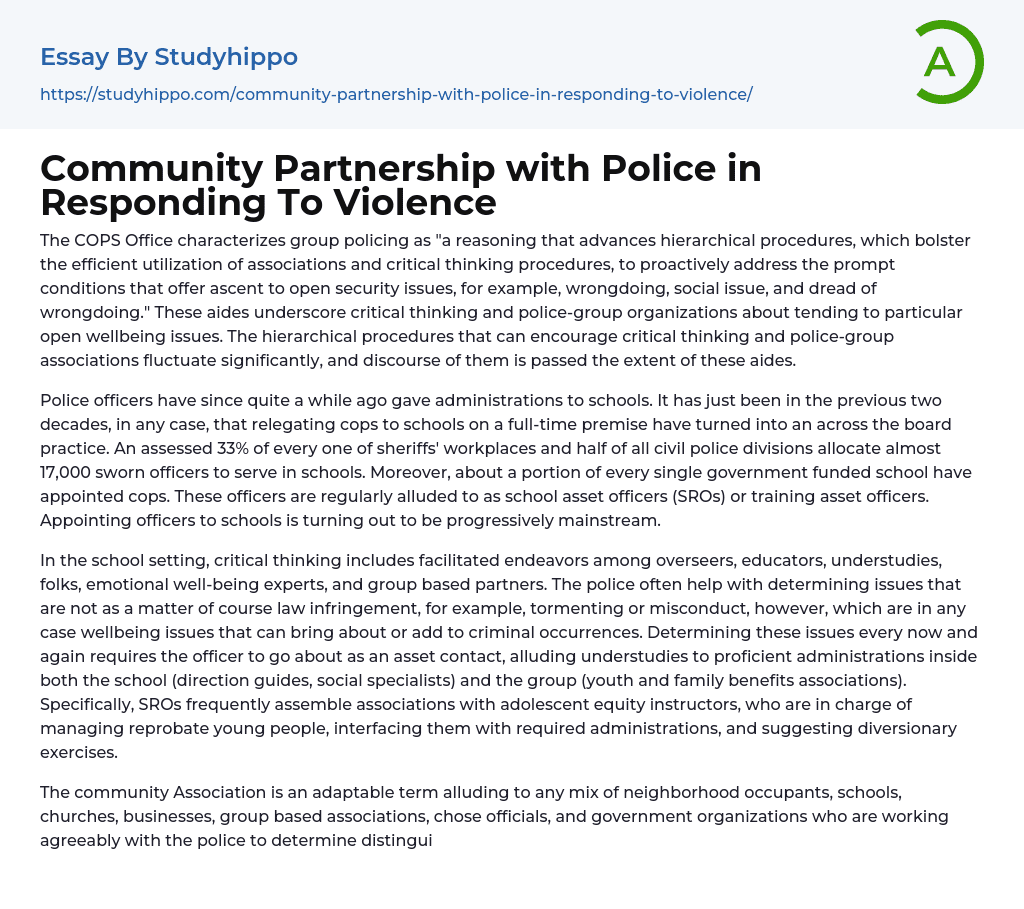

Community Partnership with Police in Responding To Violence Essay Example
Community policing, as defined by the COPS Office, involves proactive approaches to address public safety concerns like crime, social issues, and fear of crime. It promotes problem-solving and collaboration between law enforcement and the community. The specific strategies used to enhance problem-solving and police-community relationships vary greatly among organizations and are not covered in this guide.
In recent years, there has been an increase in police officers' presence in schools. Previously, officers provided services to schools on an as-needed basis. However, it has become more common for them to have full-time positions within schools over the past two decades. Currently, about 17,000 sworn officers serve in schools, with one-third of sheriffs' offices and half of municipal police departments participating. Moreover, approximately half of all public schools have designated police officers.
There is an increasing presence of officers assigned to schools, also known as school
...resource officers (SROs) or education resource officers. In order to address issues in schools, collaboration is crucial among administrators, teachers, students, parents, mental health professionals, and community-based partners. The police play a role in handling non-legal offenses like bullying or misconduct that could pose safety risks and potentially result in criminal incidents.
The officer sometimes needs to act as a resource contact and refer students to professional services both within the school (counselors, social workers) and the community (youth and family services organizations). In particular, SROs often build relationships with juvenile justice counselors, who are responsible for dealing with delinquent teenagers, connecting them with required services, and suggesting diversionary activities. The community Association is a flexible term that refers to any combination of local residents, schools, churches, businesses, community-based organizations, elected officials, and governmen
agencies who are working cooperatively with the police to resolve identified issues that affect or interest them. The association is an ongoing process— not an event. A community policing association goes beyond the public serving as the "eyes and ears" for the police.
The organization enhances the significance of members' roles by engaging them in activities addressing pressing matters. For instance, if a high school is grappling with drug problems within its premises, students can conduct surveys to assess the magnitude of the issue and devise appropriate remedies. Despite recent decreases in juvenile crime rates, there remains a potential for aggressive behavior among students. Nonetheless, by working together, school authorities and law enforcement personnel can effectively reduce this risk.
The significance of recognizing warning signs, such as familial, academic, and social progress indicators, as well as personal attributes, in the assessment of risks cannot be overstated. This assessment should encompass verbal communication, observations, and visible behaviors displayed by students. Developing a positive and collaborative relationship between law enforcement personnel and students can enhance information flow and increase the accuracy and effectiveness of risk assessments. Furthermore, establishing strong working relationships between law enforcement officers and school administrators, teachers, and parents is crucial.
References
- Brown, B. (2006). “Understanding and Assessing School Police Officers: A Conceptual and Methodological Comment.” Journal of Criminal Justice 34(6):591-604.
- Daly, N.C., and P.J. Morehead. (1992) Evaluation of Community Policing: Final Report of the Community Survey and Police Department Internal Survey.St. Petersburg, Florida: St. Petersburg Police Department.
- Dinkes,
R., E.
Cataldi, G. Kena, and K. Baum. (2006). Indicators of School Crime and Safety:2006. Washington, D.C.: U.S.
Department of Education, National Center for Education Statistics and U.S. Department of Justice. Trojanowicz, Robert C., and
Jerome Belknap. (1986). Community Policing: Training Issues. East Lansing, Mich.: National Neighborhood Foot Patrol Center, Michigan State University, School of Criminal Justice.
- A Policeman essays
- Agreement essays
- Business Law essays
- Common Law essays
- Community Policing essays
- Constitution essays
- Consumer Protection essays
- Contract essays
- Contract Law essays
- Copyright Infringement essays
- Court essays
- Crime essays
- Criminal Law essays
- Employment Law essays
- Family Law essays
- Injustice essays
- Judge essays
- Jury essays
- Justice essays
- Lawsuit essays
- Lawyer essays
- Marijuana Legalization essays
- Ownership essays
- Police essays
- Property essays
- Protection essays
- Security essays
- Tort Law essays
- Treaty essays
- United States Constitution essays
- War on Drugs essays
- Caste System essays
- Citizenship essays
- Civil Society essays
- Community essays
- Culture essays
- Deviance essays
- Discourse Community essays
- Female essays
- Filipino People essays
- Igbo People essays
- Indigenous Australians essays
- Indigenous Peoples essays
- Men essays
- Middle Class essays
- Minority Group essays
- Modern Society essays
- Popularity essays
- Social Control essays
- Social Institution essays



